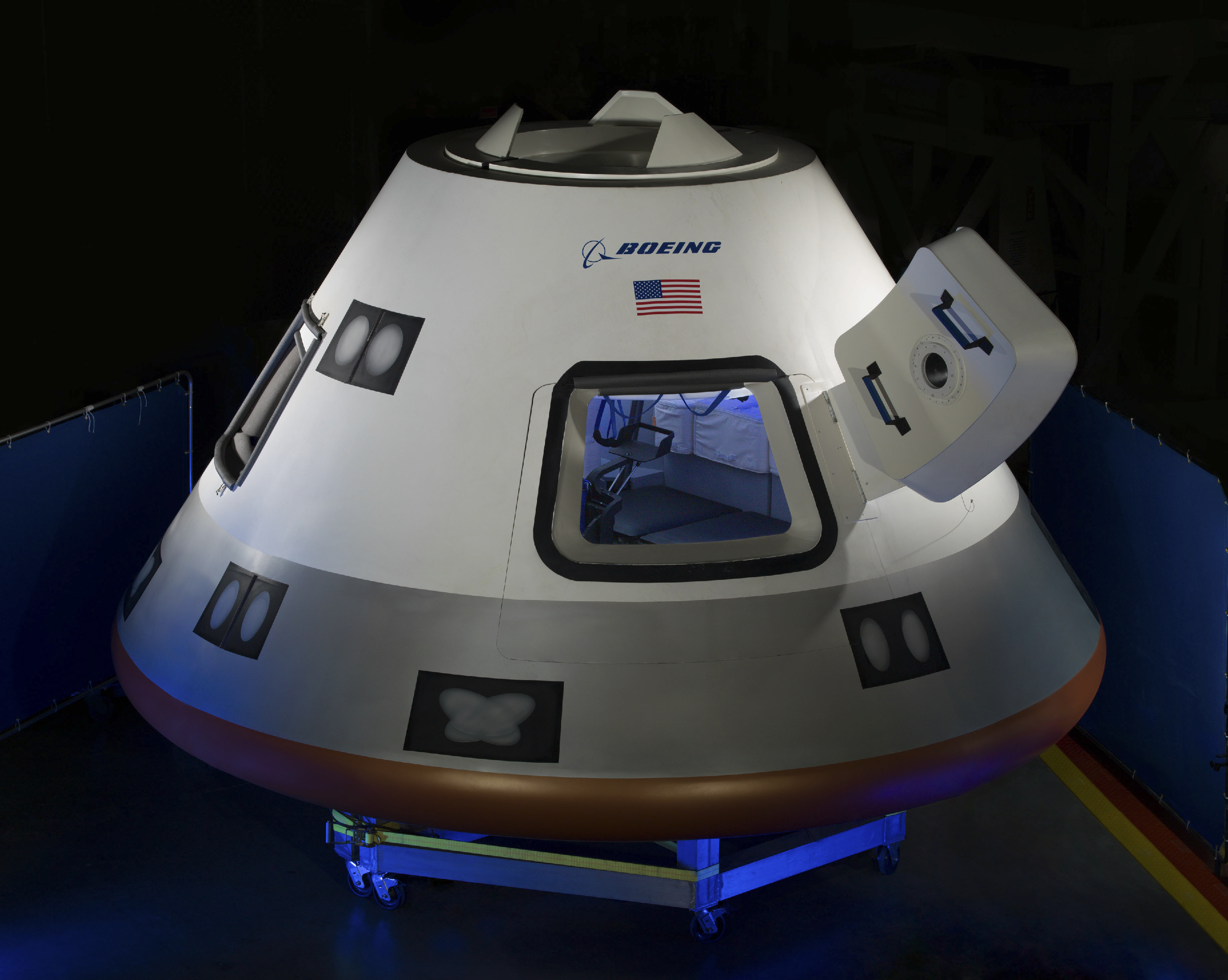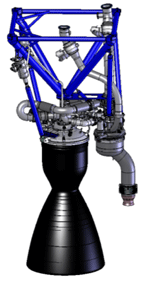|
RS-88
The RS-88 is a liquid-fueled rocket engine burning ethanol as fuel, and using liquid oxygen (LOX) as the oxidizer. It was designed and built by Rocketdyne, originally for the NASA Bantam System Technology program (1997). In 2003, it was designated by Lockheed for their pad abort demonstration (PAD) vehicle. NASA tested the RS-88 in a series of 14 hot-fire tests, resulting in 55 seconds of successful engine operation in November and December 2003. The RS-88 engine proved to be capable of of thrust at sea level. A hypergolic derivative of the RS-88 has been selected for the Boeing CST-100 Starliner launch escape system. This version is capable of 39,700lbf (176.6kN) of thrust and four are used in Starliner's abort system. Bantam Launch System The Bantam System Technology Project, which is part of the Low Cost Technologies effort, teams NASA and its business partners to research and demonstrate technologies for a new low-cost launch system. A technology demonstration flight ... [...More Info...] [...Related Items...] OR: [Wikipedia] [Google] [Baidu] |
CST-100 Starliner
The Boeing CST-100 Starliner is a class of two partially designed to transport crew to the (ISS) and other low-Earth-orbit destinations. It is manufactured by for its participation in 's |
CST-100
The Boeing CST-100 Starliner is a class of two partially designed to transport crew to the (ISS) and other low-Earth-orbit destinations. It is manufactured by for its participation in 's |
Boeing CST-100 Starliner
The Boeing CST-100 Starliner is a class of two partially designed to transport crew to the (ISS) and other low-Earth-orbit destinations. It is manufactured by for its participation in 's |
Merlin (rocket Engine)
Merlin is a family of rocket engines developed by SpaceX for use on its Falcon 1, Falcon 9 and Falcon Heavy launch vehicles. Merlin engines use RP-1 and liquid oxygen as rocket propellants in a gas-generator power cycle. The Merlin engine was originally designed for sea recovery and reuse, but since 2016 the entire Falcon 9 booster is recovered for reuse by landing vertically on a landing pad using one of its nine Merlin engines. The injector at the heart of Merlin is of the pintle type that was first used in the Apollo Lunar Module landing engine ( LMDE). Propellants are fed by a single-shaft, dual- impeller turbopump. The turbopump also provides high-pressure fluid for the hydraulic actuators, which then recycles into the low-pressure inlet. This eliminates the need for a separate hydraulic drive system and means that thrust vectoring control failure by running out of hydraulic fluid is not possible. Revisions Merlin 1A The initial version, the Merlin 1A, used an i ... [...More Info...] [...Related Items...] OR: [Wikipedia] [Google] [Baidu] |
Stennis Space Center
The John C. Stennis Space Center (SSC) is a NASA rocket testing facility in Hancock County, Mississippi, United States, on the banks of the Pearl River at the Mississippi–Louisiana border. , it is NASA's largest rocket engine test facility. There are over 50 local, state, national, international, private, and public companies and agencies using SSC for their rocket testing facilities. History The initial requirements for NASA's proposed rocket testing facility required the site to be located between the rockets' manufacturing facility at Michoud Assembly Facility in eastern New Orleans, Louisiana, and the launch facility at the Kennedy Space Center in Florida. Also, the site required barge access as the rocket motors to be tested for Apollo were too large for overland transport. Additionally, the Apollo motors were too loud to be tested at Marshall Space Flight Center's existing test stands near Huntsville, Alabama. A more isolated site was needed. After an exhaustive site ... [...More Info...] [...Related Items...] OR: [Wikipedia] [Google] [Baidu] |
Rocketdyne Engines
Rocketdyne was an American rocket engine design and production company headquartered in Canoga Park, in the western San Fernando Valley of suburban Los Angeles, in southern California. The Rocketdyne Division was founded by North American Aviation (NAA) in 1955, and was later part of Rockwell International (1967–1996) and Boeing (1996–2005). In 2005, the Rocketdyne Division was sold to United Technologies Corporation, becoming Pratt & Whitney Rocketdyne as part of Pratt & Whitney. In 2013, Pratt & Whitney Rocketdyne was sold to GenCorp, which merged it with Aerojet to form Aerojet Rocketdyne.Marjorie Censer(18 Dec 2022) L3Harris moves to acquire Aerojet Rocketdynefor $4.7 billion, after Lockheed Martin ended its attempt for Rocketdyne in Feb 2022 History After World War II, North American Aviation (NAA) was contracted by the Defense Department to study the German V-2 missile and adapt its engine to Society of Automotive Engineers (SAE) measurements and U.S. construction de ... [...More Info...] [...Related Items...] OR: [Wikipedia] [Google] [Baidu] |
Rocket Engines Using Alcohol Propellant
A rocket (from it, rocchetto, , bobbin/spool) is a vehicle that uses jet propulsion to accelerate without using the surrounding air. A rocket engine produces thrust by reaction to exhaust expelled at high speed. Rocket engines work entirely from propellant carried within the vehicle; therefore a rocket can fly in the vacuum of space. Rockets work more efficiently in a vacuum and incur a loss of thrust due to the opposing pressure of the atmosphere. Multistage rockets are capable of attaining escape velocity from Earth and therefore can achieve unlimited maximum altitude. Compared with airbreathing engines, rockets are lightweight and powerful and capable of generating large accelerations. To control their flight, rockets rely on momentum, airfoils, auxiliary reaction engines, gimballed thrust, momentum wheels, deflection of the exhaust stream, propellant flow, spin, or gravity. Rockets for military and recreational uses date back to at least 13th-century China. Signif ... [...More Info...] [...Related Items...] OR: [Wikipedia] [Google] [Baidu] |
Constellation Program
The Constellation program (abbreviated CxP) was a crewed spaceflight program developed by NASA, the space agency of the United States, from 2005 to 2009. The major goals of the program were "completion of the International Space Station" and a "return to the Moon no later than 2020" with a crewed flight to the planet Mars as the ultimate goal. The program's logo reflected the three stages of the program: the Earth (ISS), the Moon, and finally Mars—while the Mars goal also found expression in the name given to the program's booster rockets: Ares (the Greek equivalent of the Roman god Mars). The technological aims of the program included the regaining of significant astronaut experience beyond low Earth orbit and the development of technologies necessary to enable sustained human presence on other planetary bodies. Constellation began in response to the goals laid out in the Vision for Space Exploration under NASA Administrator Sean O'Keefe and President George W. Bush. O'Keef ... [...More Info...] [...Related Items...] OR: [Wikipedia] [Google] [Baidu] |
NASA Advanced Space Transportation Program
The Advanced Space Transportation Program (ASTP) is a NASA program to intentionally advance current space transportation system technologies, and innovate novel technologies, through intense research efforts that are intended to culminate in regularizing the outer space environment decades from now. The intense efforts aim to accelerate scientific and technological breakthroughs. History and funding Routine space travel As NASA's core technology program for all space transportation, the Advanced Space Transportation Program at the Marshall Space Flight Center is advancing technologies that substantially increase the safety, and reliability of space transportation, as well as reduce the cost. Presently, it costs $10,000 to put a pound of payload in Earth orbit. NASA's goal is to reduce the cost of getting to space to hundreds of dollars per pound within 25 years and tens of dollars per pound within 40 years. The high cost of space transportation coupled with unreliability c ... [...More Info...] [...Related Items...] OR: [Wikipedia] [Google] [Baidu] |
Launch Escape System
A launch escape system (LES) or launch abort system (LAS) is a crew-safety system connected to a space capsule that can be used to quickly separate the capsule from its launch vehicle in case of an emergency requiring the abort of the launch, such as an impending explosion. The LES is typically controlled by a combination of automatic rocket failure detection, and a manual activation for the crew commander's use. The LES may be used while the launch vehicle is still on the launch pad, or during its ascent. Such systems are usually of two types: *A solid-fueled rocket, mounted above the capsule on a tower, which delivers a relatively large thrust for a brief period of time to send the capsule a safe distance away from the launch vehicle, at which point the capsule's parachute recovery system can be used for a safe landing on ground or water. The tower and rocket are jettisoned from the space vehicle in a normal flight at the point where it is either no longer needed, or cannot be e ... [...More Info...] [...Related Items...] OR: [Wikipedia] [Google] [Baidu] |
Advanced Space Transportation Program
The Advanced Space Transportation Program (ASTP) is a NASA program to intentionally advance current space transportation system technologies, and innovate novel technologies, through intense research efforts that are intended to culminate in regularizing the outer space environment decades from now. The intense efforts aim to accelerate scientific and technological breakthroughs. History and funding Routine space travel As NASA's core technology program for all space transportation, the Advanced Space Transportation Program at the Marshall Space Flight Center is advancing technologies that substantially increase the safety, and reliability of space transportation, as well as reduce the cost. Presently, it costs $10,000 to put a pound of payload in Earth orbit. NASA's goal is to reduce the cost of getting to space to hundreds of dollars per pound within 25 years and tens of dollars per pound within 40 years. The high cost of space transportation coupled with unreliability c ... [...More Info...] [...Related Items...] OR: [Wikipedia] [Google] [Baidu] |







